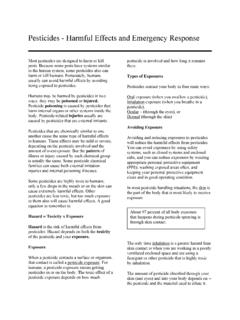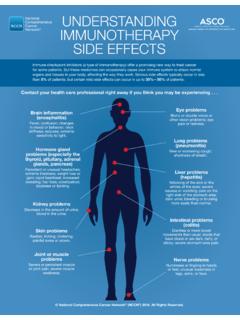Transcription of Section 1 Basic Medication Administration …
1 Section 1 DRAFT Medication Administration August 2013 5-Hour Training Course for Adult Care Homes - Draft 1-1 Section 1 Basic Medication Administration Information/Terminology Section 1 DRAFT Medication Administration August 2013 5-Hour Training Course for Adult Care Homes - Draft 1-2 Section 1 Basic Medication Administration Information/Terminology Objectives: 1. Match common medical abbreviations with their meaning. 2. List and describe common dosage forms of medications. 3. List and describe common routes of Medication Administration . 4. List the six rights of Medication Administration . 5. Describe what constitutes a Medication error and actions to take when a Medication error is made or detected. 6. Describe resident s rights regarding medications refusal, privacy, respect, and chemical restraint. 7. Define Medication allergy and describe responsibility in relation to identified allergies and suspected side effects.
2 8. Demonstrate the use of Medication resources or references. Advance Preparation In General Review curriculum and presentation materials and activity Add examples or comments If no student manual used, prepare copies of handouts for Section for each student Supplies Handouts o #1A Abbreviations o #1B Common Routes of Medication Administration o #1C Common Dosage Forms of Medications o #1D Six Rights of Medication Administration o #1E Medication Errors o #1F Residents Refusal to Take Medications Equipment and Supplies Used During Administration of Medications Refer to page 1-3 for examples of supplies and equipment to show students Medication Resources or References used at adult care home Medication Policy and Procedure for adult care home Advance Preparation Medication Resources or References Activity Refer to instructions on page 1-7 for activity Section 1 DRAFT Medication Administration August 2013 5-Hour Training Course for Adult Care Homes - Draft 1-3 Section 1 Basic Medication Administration Information/Terminology Objectives 1.
3 Match common medical abbreviations with their meaning. 2. List and describe common dosage forms of medications. 3. List and describe common routes of Medication Administration . 4. List the six rights of Medication Administration . 5. Describe what constitutes a Medication error and actions to take when a Medication error is made or detected. 6. Describe resident s rights regarding medications refusal, privacy, respect, and chemical restraint. 7. Define Medication allergy and describe responsibility in relation to identified allergies and suspected allergic reactions. 8. Demonstrate the use of Medication resources or references. Content TEACHING TIP: Infection Control Course Determine whether students have had the Infection Control Course required for adult care home staff. If not, the student should complete the training as soon as possible. Information on infection control in this course is minimal. TEACHING TIP: Abbreviations If available, locate the approved abbreviation list at the adult care home and point out this to the students.
4 Common Abbreviations Abbreviation a shortened form of a word or phrases Often used in medical and residents records, such as physician s orders Medication Aides must learn abbreviations for terms common to Medication Administration On the Medication Administration Record (MAR), abbreviations should be spelled out Be aware that abbreviations can lead to mistakes if they are not clear Always check with the supervisor if you have questions about abbreviations HANDOUT #1A: Abbreviations Distribute a copy of the handout, Abbreviations to each student, or locate handout in Student Manual Section 1 DRAFT Medication Administration August 2013 5-Hour Training Course for Adult Care Homes - Draft 1-4 Section 1 Basic Medication Administration Information/Terminology TEACHING TIP: Abbreviations Handout Tell students: These are abbreviations that you will see frequently when you give medications to your residents.
5 You must learn these abbreviations and pass a test that includes the common abbreviation. HANDOUT #1B: Common Routes of Medication Administration Distribute a copy of the handout on Common Routes of Medication Administration to each student or locate handout in Student Manual TEACHING TIP: Common Routes of Medication Administration Referring to the handout and the content below, discuss the common routes of Medication Administration . Use visual aids if available. Common Routes of Medication Administration Oral taken by the mouth and swallowed Buccal placed between cheek and gum Sublingual placed under the tongue Eye placed in the pocket of the eye created when the lower eyelid is gently pulled down Ear placed in the ear canal created when the external ear is pulled up and back Nasal placed in the nostril Inhalant inhaled into the lungs Transdermal placed and affixed to the skin Topical applied to the skin or hair Vaginal inserted into the vagina Rectal inserted into the rectum Subcutaneous injected into the fat with a syringe HANDOUT #1C: Common Dosage Forms of Medications Distribute a copy of the handout on Common Forms of Medications to each student or locate handout in Student Manual TEACHING TIP.
6 Common Dosage Forms of Medications Referring to the handout and the content below, discuss the common dosage forms of Medication Administration . Use visual aids if available. Section 1 DRAFT Medication Administration August 2013 5-Hour Training Course for Adult Care Homes - Draft 1-5 Section 1 Basic Medication Administration Information/Terminology Common Dosage Forms of Medications Tablet o Hard, compressed Medication in round, oval, or square shape o Some have enteric coating or other types of coatings, which delay release of the drug and can not be crushed or chewed Capsule o In a gelatin container that may be hard or soft o Dissolves quickly in stomach Liquid different types of liquid medications o Solution a liquid containing dissolved Medication o Suspension a liquid holding un-dissolved particles of Medication and must be shaken before measuring and administering to resident o Syrup a liquid Medication dissolved in a sugar water to disguise its taste o Elixir a sweet alcohol based solution in which medications are dissolved Suppository o Small solid medicated substance, usually cone-shaped o Melt at body temperature o May be administered by rectum or vagina o Refrigerate as directed by manufacturer Inhalant o Medication carried into the respiratory tract using air, oxygen or steam o Inhalants may be used orally or nasally Topical applied directly to the skin surface.
7 Topical medications include the following: o Ointment a semisolid substance for application of Medication to the skin or eye o Lotion a Medication dissolved in liquid for applying to the skin o Paste a semisolid substance thicker and stiffer than an ointment containing medications o Cream semisolid preparation holding Medication so it can be applied to skin o Shampoo liquid containing Medication that is applied to the scalp and hair o Patches (transdermal) Medication encased in a round, square, or oval disc that is affixed to the skin o Powder fine, ground form of Medication that may be used to be swallowed, or may be used as on the skin for rashes o Aerosol sprays solution that holds the Medication suspended until it is dispensed in the form of a mist to spray on the skin Teaching Tip: Introduction to Equipment and Supplies Used During Administration of Medication Show examples of supplies and equipment used during Medication Administration .
8 Section 1 DRAFT Medication Administration August 2013 5-Hour Training Course for Adult Care Homes - Draft 1-6 Section 1 Basic Medication Administration Information/Terminology Equipment and Supplies Used During Administration of Medication Medication cart MAR for each resident Souffl cups for oral medications in pill or capsule form Calibrated plastic cups and oral syringes or droppers for oral liquid medications Alcohol wipes for use with injections Insulin syringes for use with insulin Administration Sharps equipment Bandaids for use with injections Lubricant for use with suppositories Blood pressure cuff, stethoscope, blood glucose meter as needed Gloves to use when coming into contact with mucus membranes (administering vaginal or rectal suppositories) and blood/body fluids (administering injections) Water cup and water for resident to drink when taking oral medications Soap/water/paper towels or alcohol-based hand rubs to use before preparing medications/before Administration of Medication to each resident/after Administration of Medication to each resident Food, such as applesauce or pudding to use when administering crushed medications HANDOUT #1D: Six Rights of Medication Administration Distribute a copy of the handout on Six Rights to each student or locate handout in Student Manual Referring to the handout and the content below, discuss the Six Rights of Medication Administration .
9 Six Rights of Medication Administration A method used during Medication Administration to safeguard the residents; before administering the Medication the Medication Aide must ask self six questions Am I giving the Medication to the right resident? Am I giving the right Medication ? Am I giving the right dose? Is this the right route? Is this the right time? Have I done the right documentation? o Right resident identify resident to assure you are giving the Medication to the resident who is supposed to receive the Medication and using procedure required by the facility, such as photo on the MAR, asking a resident his/her name, etc o Right Medication the name of the Medication ordered by the physician; always use the three checks o Right dose the amount of Medication ordered o Right route the method of Medication Administration o Right time when the resident is ordered to receive the Medication o Right documentation the process of writing down that a Medication was administered to the resident on the MAR and writing down if a Medication ordered was not administered and the reason it was not administered Section 1 DRAFT Medication Administration August 2013 5-Hour Training Course for Adult Care Homes - Draft 1-7 Section 1 Basic Medication Administration Information/Terminology HANDOUT #1E: Medication Errors Distribute a copy of the handout on Medication Errors to each student or locate handout in Student Manual Referring to the handout and the content below, discuss the definition of Medication errors, examples and the Medication Aide s role.
10 Medication Errors Described occurs when the Administration of a Medication is not as prescribed by the doctor or prescribing practitioner Examples o Omissions o Administration of a Medication not prescribed by the prescribing practitioner o Wrong dosage, wrong time, or wrong route o Crushing a Medication that shouldn t be crushed o Documentation errors Medication Aide s role o Understand the facility s Medication error policy and procedure or know where to locate it o Recognizes when a Medication error is made o Understands importance of acting quickly to report and correct Medication errors to help prevent more serious problems Medication Administration and Resident s Rights Importance and Examples Respect how the resident is addressed o Do not interrupt resident while eating for the Administration of medications, such as oral inhalers and eye drops o Do not awaken resident to administer a Medication that could be scheduled or administered at other times o Inform resident about the procedure that is about to perform o Answer resident s question about Medication Refusal resident has the right to refuse medications o Never force a resident to take a Medication o Follow the facility s policy and procedure when a resident refuses medications (policy and procedure ensures that physician is notified in a timely manner based on resident s physical and mental condition and the Medication Privacy being away from the public o Knock on closed doors before entering o Do not administer medications when resident is receiving personal care or in bathroom Section 1 DRAFT Medication Administration August 2013 5-Hour Training Course for Adult Care Homes - Draft 1-8 Section 1 Basic Medication Administration )







